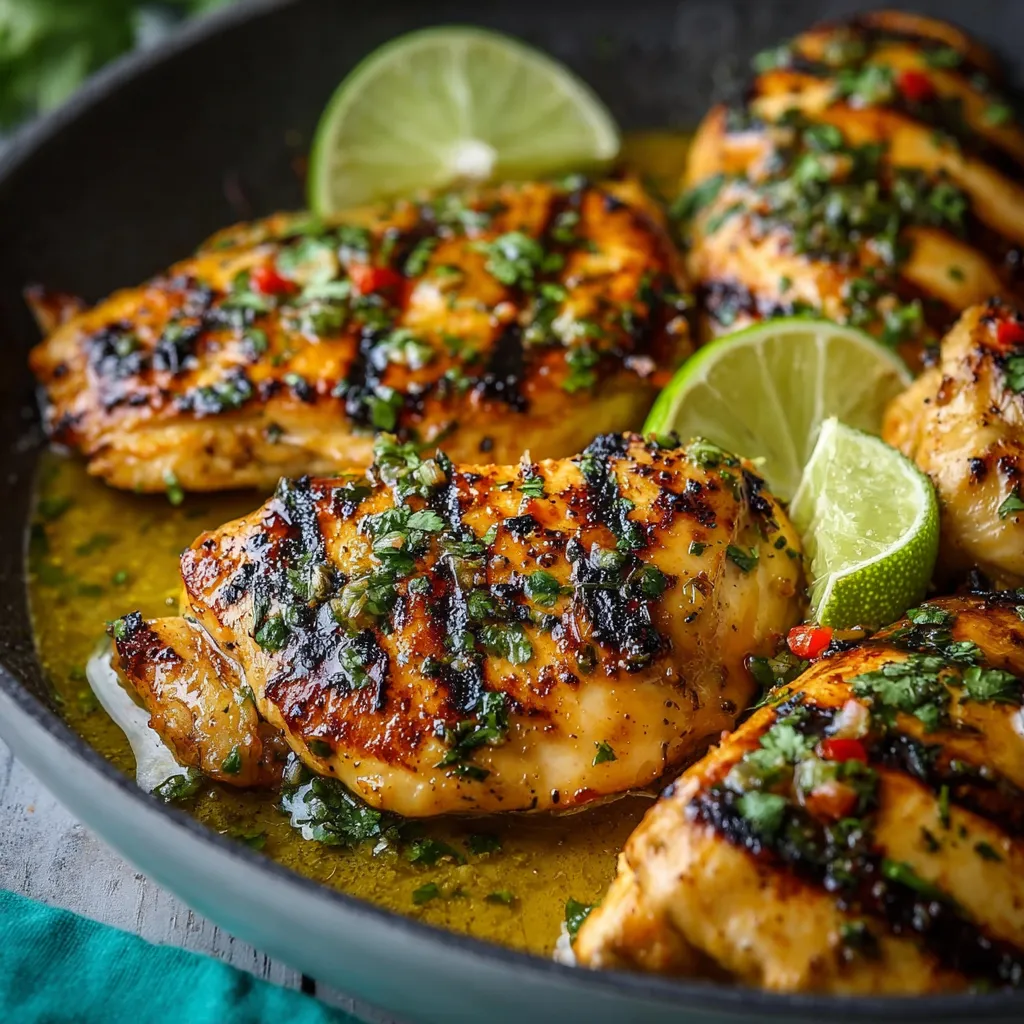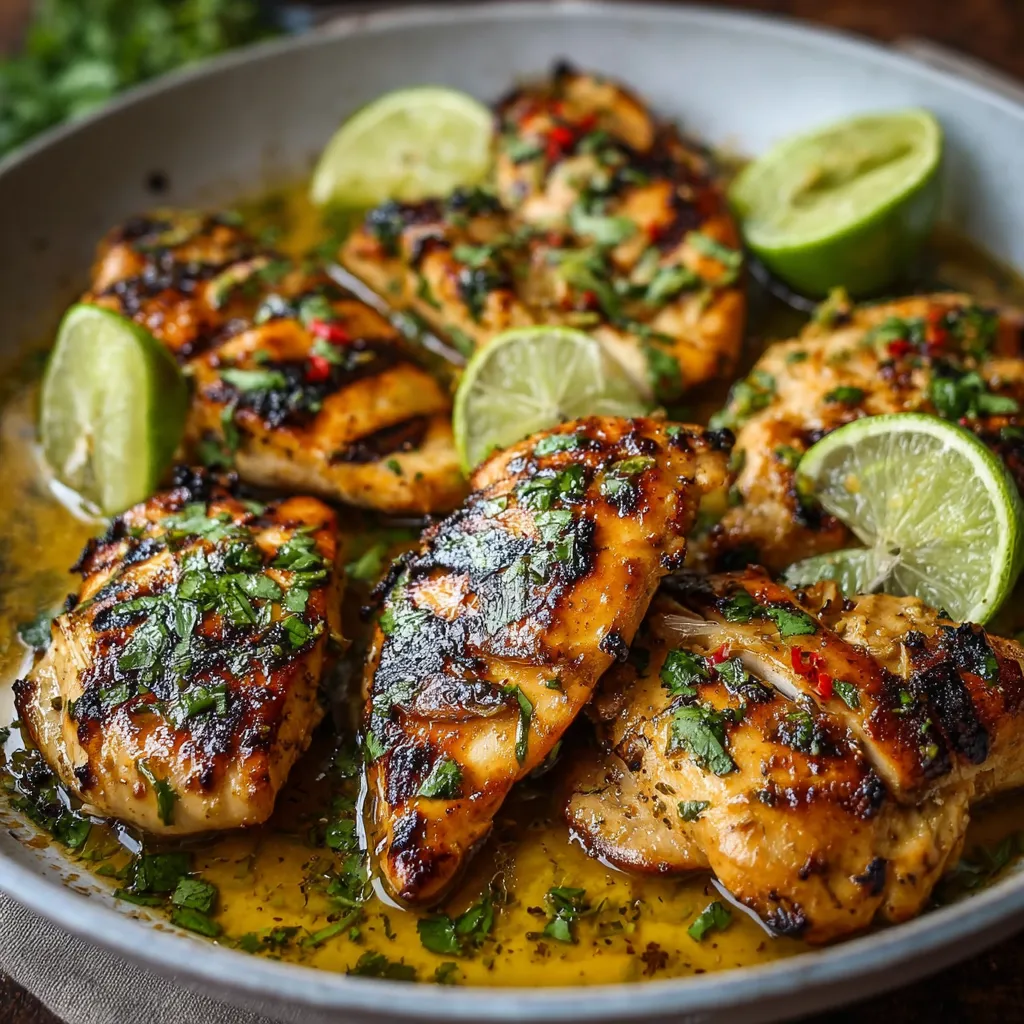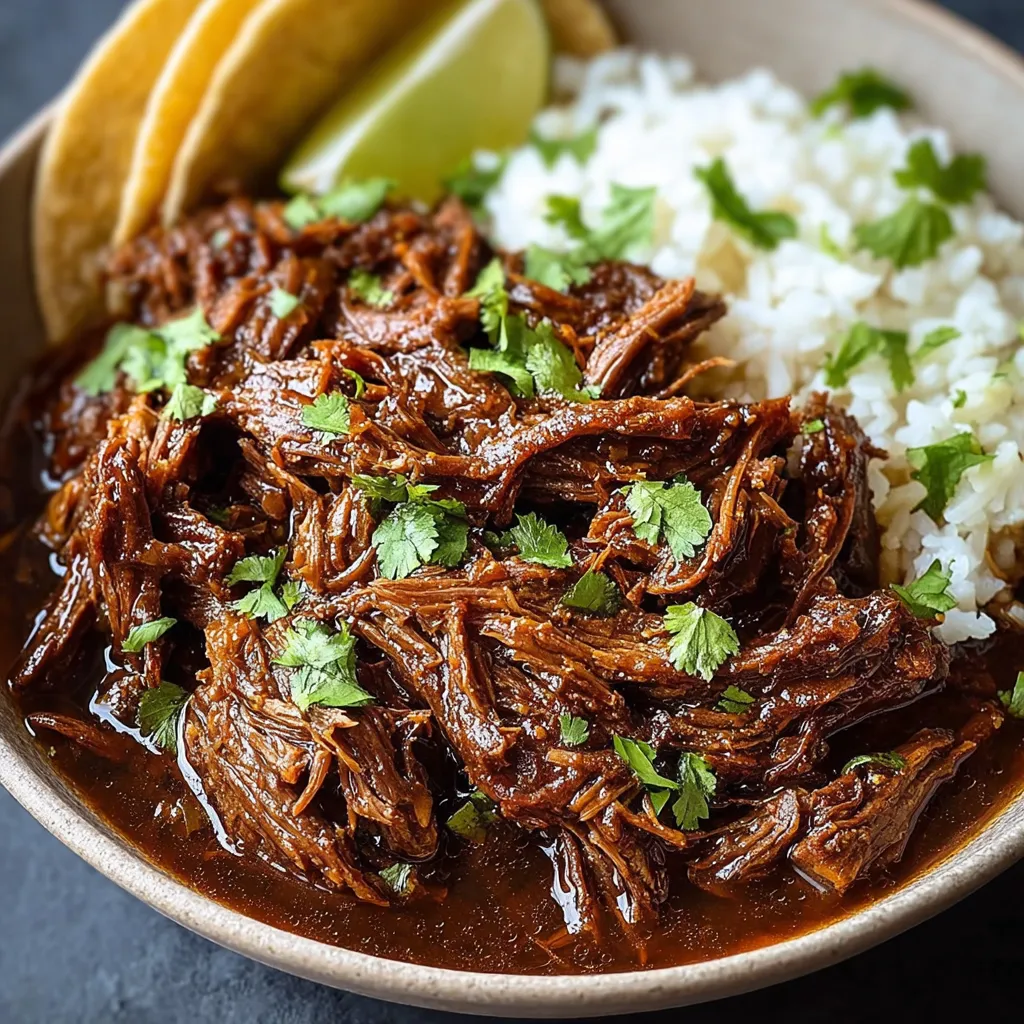The Zestful Science Behind the Flavor
At its core, Cilantro Lime Chicken relies on a harmonious interplay of acidity, aromatics, and the Maillard reaction. The lime juice, rich in citric acid, not only tenderizes the chicken but also provides that characteristic tang. The cilantro, with its unique volatile compounds, contributes a fresh, herbaceous note. But, the true magic happens when these elements combine with heat. The Maillard reaction, a chemical reaction between amino acids and reducing sugars, is responsible for the browning and development of complex flavors on the surface of the chicken. Salt also plays a crucial role, enhancing flavor and aiding in moisture retention. Understanding these principles allows us to control and optimize the final outcome, preventing common pitfalls like dry chicken or a muddled flavor profile. Furthermore, the fat content of the marinade and the cooking method significantly impact the chicken’s final texture and flavor.The Holy Grail Recipe
 Here’s the recipe I’ve painstakingly perfected, guaranteeing consistent results:
Here’s the recipe I’ve painstakingly perfected, guaranteeing consistent results:
Ingredients:
- 1.5 lbs boneless, skinless chicken breasts
For the Marinade:
- 1/4 cup lime juice (freshly squeezed, about 3-4 limes)
- 2 tablespoons olive oil
- 2 cloves garlic, minced
- 1/2 cup cilantro, roughly chopped
- 1 teaspoon cumin powder
- 1/2 teaspoon chili powder
- 1/2 teaspoon salt
- 1/4 teaspoon black pepper
Instructions:
- Prepare the Chicken: If the chicken breasts are thick, pound them to an even thickness of about 1/2 inch. This ensures even cooking.
- Make the Marinade: In a medium bowl, whisk together the lime juice, olive oil, garlic, cilantro, cumin powder, chili powder, salt, and pepper.
- Marinate the Chicken: Place the chicken breasts in a zip-top bag or a shallow dish. Pour the marinade over the chicken, ensuring each piece is well coated. Seal the bag or cover the dish and refrigerate for at least 30 minutes, or up to 4 hours. (Do not marinate for longer than 4 hours, as the lime juice can start to break down the chicken too much, resulting in a mushy texture.)
- Cook the Chicken: There are several cooking options:
- Grilling: Preheat grill to medium-high heat. Grill the chicken for 5-7 minutes per side, or until cooked through and the internal temperature reaches 165°F (74°C).
- Pan-Searing: Heat 1 tablespoon of olive oil in a large skillet over medium-high heat. Sear the chicken for 5-7 minutes per side, or until cooked through.
- Baking: Preheat oven to 400°F (200°C). Place the chicken in a baking dish and bake for 20-25 minutes, or until cooked through.
- Rest and Serve: Let the chicken rest for 5 minutes before slicing and serving. Garnish with extra cilantro and a squeeze of lime juice.
Serving Suggestions:
- Serve over rice with black beans and avocado.
- Use in tacos or burritos.
- Add to salads.
- Make a Cilantro Lime Chicken bowl with your favorite toppings.
Decoding the Perfect Bird: My Culinary Investigation
The Early Days: A Citrus Overload
My first few attempts were a disaster. I, like many of you, initially thought more lime juice meant more flavor. I’d soak the chicken for hours, only to end up with rubbery, sour meat. The cilantro, often added as an afterthought, would wilt and lose its vibrancy. I quickly realized that the key was not just *what* I was using, but *how* I was using it.The Marinade Revelation: Finding the Sweet Spot
Then, I had an “Aha!” moment while experimenting with other chicken marinades. I realized the importance of balance. The lime juice needed to be tempered with oil to protect the chicken from excessive acidity. The cilantro needed to be added closer to cooking time to preserve its freshness. And the addition of spices like cumin and chili powder added depth and complexity to the flavor profile. The Boursin Chicken Pasta is a great example of how different herbs and spices can transform a chicken dish, but in this case, cilantro and lime had to be the stars.Cooking Catastrophes: Conquering the Dryness Dilemma
Next came the cooking methods. Baking yielded dry, bland chicken. Pan-searing was better, but often resulted in uneven cooking. Grilling, when done correctly, produced the best results, but required constant attention to prevent burning. I experimented with different temperatures, cooking times, and even brining the chicken beforehand. Eventually, I discovered that pounding the chicken to an even thickness and using a meat thermometer were crucial for achieving consistently juicy and perfectly cooked chicken. Learning from my failures with the Ruth’s Chris Stuffed Chicken, I knew precise internal temperatures were key.The Final Flourish: Presentation and Perfection
Finally, I focused on presentation. A simple garnish of fresh cilantro and a squeeze of lime juice elevated the dish from ordinary to extraordinary. And serving it with complementary sides like rice, black beans, and avocado created a complete and satisfying meal. I even considered incorporating elements from the Bbq Chicken Flatbread by adding a cilantro-lime crema as a topping.The Foolproof Method: A Step-by-Step Guide
This isn’t just a recipe; it’s a reliable system. Follow these steps and you’ll achieve Cilantro Lime Chicken perfection:- Pound the Chicken: Ensure even thickness for uniform cooking.
- Marinate Briefly: 30 minutes to 4 hours is the sweet spot. Avoid over-marinating.
- Preheat Properly: Whether grilling, pan-searing, or baking, ensure your cooking surface is at the right temperature.
- Monitor Internal Temperature: Use a meat thermometer to ensure the chicken reaches 165°F (74°C). This is non-negotiable!
- Rest Before Slicing: Allow the chicken to rest for 5 minutes to retain its juices.
- Garnish Generously: Fresh cilantro and a squeeze of lime juice make all the difference.
Why is it important to not marinate the chicken for longer than 4 hours?
Marinating the chicken for longer than 4 hours can cause the lime juice to break down the chicken too much, resulting in a mushy texture.
What is the ideal internal temperature that the chicken should reach when cooking?
The chicken should reach an internal temperature of 165°F (74°C) to ensure it is cooked through.
Why is pounding the chicken breast to an even thickness important?
Pounding the chicken breast to an even thickness ensures that it cooks evenly, preventing some parts from being overcooked and dry while others are undercooked.
What role does the Maillard reaction play in achieving optimal flavor?
The Maillard reaction, a chemical reaction between amino acids and reducing sugars, is responsible for the browning and development of complex flavors on the surface of the chicken.

Easy Cilantro Lime Chicken
Ingredients
Equipment
Method
- Prepare the Chicken: If the chicken breasts are thick, pound them to an even thickness of about 1/2 inch to ensure even cooking.
- Make the Marinade: In a medium bowl, whisk together the lime juice, olive oil, garlic, cilantro, cumin powder, chili powder, salt, and pepper.
- Marinate the Chicken: Place the chicken breasts in a zip-top bag or a shallow dish. Pour the marinade over the chicken, ensuring each piece is well coated. Seal the bag or cover the dish and refrigerate for at least 30 minutes, or up to 4 hours. Do not marinate for longer than 4 hours.
- Cook the Chicken (Grilling): Preheat grill to medium-high heat. Grill the chicken for 5-7 minutes per side, or until cooked through and the internal temperature reaches 165°F (74°C).
- Cook the Chicken (Pan-Searing): Heat 1 tablespoon of olive oil in a large skillet over medium-high heat. Sear the chicken for 5-7 minutes per side, or until cooked through and the internal temperature reaches 165°F (74°C).
- Cook the Chicken (Baking): Preheat oven to 400°F (200°C). Place the chicken in a baking dish and bake for 20-25 minutes, or until cooked through and the internal temperature reaches 165°F (74°C).
- Rest and Serve: Let the chicken rest for 5 minutes before slicing and serving. Garnish with extra cilantro and a squeeze of lime juice.




